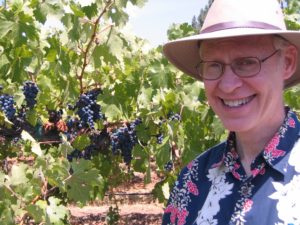By Jacob Kamaras

LA JOLLA, California — As Dr. Jon Greenberg views Jewish history, “Anything terrible that happened, it’s going to become dessert.”
The Passover Seder’s haroset symbolizes the cement that the Jews used to build pyramids while enslaved in Egypt. In different Jewish communities around the world, essentially every part of the Purim story villain Haman’s body is turned into a dessert. And in Italian Jewish culture, the sweet honey and nut-filled biscuits called sfratti resemble the clubs that landlords would carry when attempting to evict them.
On February 22, Greenberg will bring his unique perspective on Jewish tradition to the vegetable gardens of the Coastal Roots Farm in Encinitas for “Torah Flora: A Biblical Nature Walk,” a program presented by the Lawrence Family Jewish Community Center (including its JLearn and Seniors departments), Congregation Beth Israel, and Coastal Roots Farm.
“There is a hidden meaning in everything if you walk around,” Greenberg tells the San Diego Jewish World.
Greenberg publishes the website Tora Flora website (torahflora.org), which is devoted to biblical ethnobotany, a way of using the tools of botany and ethnobotany to enhance understanding the Torah. A frequent speaker at synagogues, schools, and botanical gardens, he earned his bachelor’s degree in biology from Brown University, and his master’s and doctorate in agronomy from Cornell University. He has also studied with Rabbi Chaim Brovender at Israel’s Yeshivat Hamivtar and conducted research on corn, alfalfa, and soybeans at Cornell, the U.S. Department of Agriculture, and the University of Pennsylvania’s Institute for Cancer Research. He has taught at the Heschel School in New York City since 2008.
During his first-ever presentation in San Diego County (he previously held a Los Angeles-area speaking tour in 2017), Greenberg says he will explain how “just about every family of vegetable out there has some wonderful story, some Jewish story, some biblical story associated with it.” He also notes that “in many ways, with the increase in the fires and the drying of Southern California, the climate in this region, which was already pretty similar to some parts of Israel, is becoming even more so like Israel’s climate.”
Greenberg’s lectures emphasize how contrary to popular belief, Torah and science are not mutually exclusive or hostile to each other. Rather, Torah lovers can love science, or vice versa. Although most people who attend his events are accepting of both Torah and science, “my real goal is to speak to people who aren’t,” he says.

The ethnobotanist’s smorgasbord of knowledge on Jewish food is bound to whet the intellectual appetite of anyone who attends his talk at Coastal Roots Farm. For instance, I was previously only aware of the Hebrew translation of hamantashen to oznei Haman, meaning Haman’s ears. When speaking to Greenberg, I discovered the German montaschen, which are poppy seed pockets; a game in which Greek Jews would play cards on Purim and the winner would receive Haman’s foot, a cake with a hardboiled egg embedded inside; Morocco’s einei Haman (Haman’s eyes) — challah with seeds, sesame, carraway, fennel, almonds, two hardboiled eggs inside, and crisscrossed dough, creating the appearance of a face with two eyes.
More hidden stories uncovered by Greenberg surround the vegetables on the Passover Seder plate, maror and karpas. He explains that in Roman times, there was a polar opposition between lettuce and arugula. Lettuce is derived from a wild plant with mild narcotic properties that was used until the early 20th century to relieve pain, like Tylenol is used today. In Beatrix Potter’s The Tale of Peter Rabbit, lettuce is described as “soporific.” Arugula, by contrast, is spicy and wakes people up — so much so that in Medieval Italy, it was considered an aphrodisiac and was forbidden in monasteries. All of this historical context led to Greenberg’s immense confusion when he witnessed arugula being served to teenagers in a Jewish high school cafeteria.
Ultimately, although the Torah leads many observers to question science, Greenberg believes that “if you see the natural setting it makes a lot more sense.”
“Torah Flora: A Biblical Nature Walk” will be held on Tuesday, February 22, from 1-2:30 p.m. at Coastal Roots Farm, 441 Saxony Rd in Encinitas. Tickets — $18 per person, or $15 for LFJCC members — are available here.
*
Jacob Kamaras is Editor and Publisher of the San Diego Jewish World